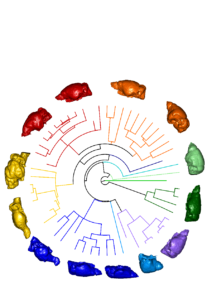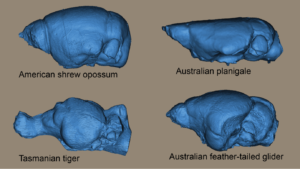Being squeezable may be the key to finding space for the brain in mammals, including humans, according to new research.
An international study, co-led by Flinders University's Dr Vera Weisbecker, has revealed that marsupial mammals like possums, kangaroos, and wombats appear to have a lot of flexibility when it comes to accommodating their brains into their skulls.
"The brain is one of the heaviest parts of the head, particularly in smaller mammals. But it needs to be placed in a way that doesn't interfere with the many vital functions of the head, such as seeing, hearing, smelling and of course feeding," says Dr. Weisbecker.
"Stowing" a large brain into the head is a general challenge for mammals, which have much larger brains relative to their body size compared to their reptile-like ancestors. It is also a particularly intriguing issue in humans and their primate relatives, which tend to have extremely large relative brain sizes compared to other mammals."
"We wanted to use a diverse group of mammals to assess if there is general pattern of brain shape variation to explain the ability of mammals to fit their brains into the great diversity of head shapes without interfering with head function. Marsupial mammals fit the bill perfectly because they are a well-understood group of mammals with diverse head sizes and functions."
The team used CT scanning and 3D visualisation to extract the shape of the brain cavity in the diverse group of Australian marsupial mammals.

"These so-called "endocasts" give us a good idea of what the brain itself looks like", says Dr. Weisbecker.
"I then placed landmarks - which work a bit like a coordinate system for shape - all over the endocasts of just under 60 marsupial species, including some really cool fossils like the marsupial lion."
When co-author Dr. Emma Sherratt from The University Of Adelaide analysed the data, the team were in for a surprise.
"The biggest difference between the brains is basically whether they are more cylindrical or more globular. We were struck by how extreme this stretch-compress pattern was - we saw brains that look like marbles, and others that nearly look like tubes!"says Dr. Sherratt.
"Intriguingly, this matches the characteristically rounded shape of the human brain, which is sometimes thought to arise from the need to "stack" all the brain tissue into the skull efficiently," says Dr. Weisbecker.
"It is therefore possible that human brain shape arises from an ancient general tendency of the brain to assume a range of shapes from rounded to elongate."

Another interesting find was the many unusual brain shapes the team saw.
"Within the general pattern of spherical versus stretched-out, we saw some outlandish endocast shapes. For example, some species had totally flat brains, while others seemed to have parts of the brain "squished aside" by the bone around the middle ear."
The researchers say the Tasmanian tiger has enormous olfactory bulbs, which are responsible for smell, and some unusually compact and rounded cerebral hemispheres.
"We believe that a round-to-cylindrical brain shapes are probably the most easily achieved evolutionary pathway of fitting the brain into the skull. However, within this overall pattern, the brain seems incredibly flexible, nearly as if it was toothpaste than can be squeezed into any mould," says Dr. Weisbecker.
"This might also explain why we saw substantially different brain shapes in individuals of the same species."
The teams find matches well with evidence that the brain of some mammals can change size and shape during an animals' lifetime.
"We suspect that a flexible brain is the key to success in other animals as well. For example, some crocodiles and ancient coelacanth fishes have extremely long brains; and birds have their eyes imprinted on their brain shape. It appears that the brain is capable of functioning regardless of where it goes in the skull."
The research shows brain function might not be easy to determine from brain shape.
"We found no correspondence of brain shape with movement patterns, for example if animals a species climbs trees, glides, hops, or walks on all fours."
"We suspect that the overall shape of the brain is more determined by the requirements of the skull than brain function. Understanding specific adaptations of the brain probably require investigation of finer detail than overall brain shape."






